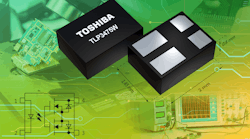The most basic on/off relay-switching function, conventionally designated as 1-Form A (Normally Open - NO), can be satisfied by an electromechanical relay (EMR) or a solid-state relay (SSR), but that’s only part of the relay story. For high-speed signals, especially those in automatic test equipment (ATE), parameters such as parasitic capacitance and inductance, along with associated insertion loss, are also critical.
Addressing this situation, Toshiba Electronics introduced the TLP3475W photorelay (often called an SSR), which reduces those contributors to insertion loss. It targets the high-frequency signals associated with semiconductor testing applications such as high-speed memory testers, high-speed logic testers, or probe cards (Fig. 1).
With its optimized package design, this photorelay provides functionality up to 20 GHz (typical)—a 50% improvement in performance over the existing predecessor TLP3475S photorelay—and competes with reed relays that are also compact, reliable, and support wideband operation.
Maximum off-state output-terminal voltage is at least 60 V, while isolation voltage (BVs) exceeds 300 V rms. Output capacitance (COFF) is less than 20 pF, contributing to switching times in the region of 2 ms. Operating temperature range is −40 to +110°C, suiting it for industrial applications as well as high-speed semiconductor testing, where modest ambient temperatures are countered by high duty cycles and load factors that may cause an increase in internal heat (Fig. 2).
The TLP3475W comes in a WSON4 package measuring just 1.45 × 2.0 × 0.8 mm, making it one of the smallest photorelays currently available. This size is 40% smaller than Toshiba's already established ultra-compact S-VSON4T package. Thus, it’s a good fit for the dense multi-channel designs where multiple devices are used on a single card, often the situation in ATE systems.
Details are in the photorelay’s 11-page datasheet. There’s also a 14-page application note, “Points for photorelays in high frequency circuit applications,” which provides additional perspectives including models of parasitic inductance and capacitance in on/off states, along with discussion of S-parameters and insertion loss.


